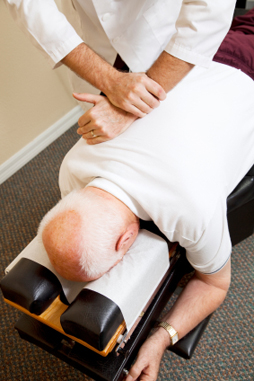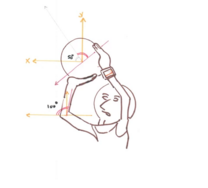Pelvic Discomfort
- Details
- Category: Our History
- Published on Sunday, 14 July 2013 01:27
- Written by Administrator
- Hits: 9005
Highlight Terms 
|
||
| OBJECTIVE: To assess the role of chiropractic care for women with chronic pelvic pain (CPP) as a first step in designing a randomized clinical trial. DESIGN: Prospective single-group intervention study. SETTING: Chiropractic Research Center. SUBJECTS: Nineteen volunteer female subjects meeting inclusion/exclusion criteria for chiropractic treatment of chronic pelvic pain. INTERVENTIONS: Chiropractic treatment consisting of flexion/distraction and trigger point techniques administered by faculty clinician over a period of 6 wk. MAIN OUTCOME MEASURES: Pain Disability Index (PDI) was the primary measure; secondary outcome measures were Visual Analog Scale for pain (VAS), RAND-36 Health Survey and BeckDepression Inventory (BDI). All were administered at baseline and at 6 wk. RESULTS: Eighteen subjects completed the study, with an attrition rate of 5%. The mean improvement in the PDI score was 13.0 points (p =.001); in the VAS it was 4.0 cm (p =.001); and in the BDI it was 6.1 points (p <.001). All eight subscales of the RAND-36 Health Survey increased post-intervention, with the largest differences in role function limitations because of physical problems (45.8%), emotional problems (44.4%) and pain (40.6%). CONCLUSION: The chiropractic treatment used in this study had positive short-term effects. These results will be used to design a randomized clinical trial to investigate the efficacy of chiropractic care in the treatment of CPP. |
Chiropractic Research
- Details
- Category: Our History
- Published on Friday, 12 July 2013 23:38
- Written by Administrator
- Hits: 10615
MRC trial in 1991 and its follow-up in 1995, which showed that chiropractic is the most effective treatment for low back pain.LINK to research.
Research article indicating that manipulation was effective and also cost-effective for back pain. LINK to research.
Manipulation for treatment of chronic and acute pain. LINK to research.
Effectiveness and cost effectiveness of Chiropractic for low back pain: LINK to research.
Cost effectiveness of Chiropractic compared to orthopedic, rhematology and surgery: The Manga Report:
"Chiropractic care is a cost-effective alternative to the management of neuromusculoskeletal conditions. It is also safer, increasingly accepted by the public as reflected in the growing utilization and high patient retention rates and there is much and repeated evidence that patients prefer chiropractic over other forms of care for the more common musculoskeletal conditions. The integration of chiropractic into the health care system should serve to reduce health care costs, improve accessibility to needed care, and improve health outcomes. There is an extensive body of literature demonstrating that chiropractic care for NMS disorders is effective though there (are) studies that question or dispute this finding. Suffice to say that there is not nearly as much nor as convincing evidence for the effectiveness of medical management of these conditions. Additionally, there is a strong and compelling consensus that chiropractic is safer, and patient satisfaction is higher than for other professions."
"The Economic Case for the Integration of Chiropractic Services into the Health Care System", by Pran Manga, Ph.D., University of Ottawa, Ottawa, Ontario, Canada.
Funded By The Ontario Ministry Of Health
written by:
1 Pran Manga, Ph.D.: Professor and Director, Masters in Health Administration Program, University of Ottawa; and President, Pran Manga and Associates Inc., Ottawa.
2 Douglas E. Angus, M.A.: Adjunct Professor, University of Ottawa and Project Director, The Cost-Effectiveness of the Canadian Health Care System, Queen's - University of Ottawa Economic Projects.
3 Costa Papadopoulos, MHA: Health Care Consultant and Associate of Pran Manga and Associates, Inc.
4 William R. Swan, B.Comm.: Consultant in Health Care Economics.
August 1993
Posture
- Details
- Category: Our History
- Published on Friday, 12 July 2013 22:29
- Written by Administrator
- Hits: 11168
Having the correct posture during sports is important. Sports Tutor Watch helps you correct your posture and line of drive. You have to hold the ball at a proper angle and release it at a proper angel.
Ergonomics
- Details
- Category: Our History
- Published on Friday, 12 July 2013 22:48
- Written by Administrator
- Hits: 9863
Laptop and Briefcase Ergonomics
I often see patients who have problems that are aggravated by improper lifting, prolonged sitting behind laptops, over exercising and under exercising. Some decide to become athletes after leaving sports for years.
Traveling or tips for carrying: Here are some simple strategies to prevent injury while travelling with work related items
Buy light bags with padded shoulder straps. Double strap is preferred. When lifting use for knees. Do not lift objects that you are not used to. If you are changing residence use moving companies. Lift evenly so that your left and right side are lifting equally. Do no wobble. Use bags that have wheels. Maintain good posture. Neck is slightly back, chest extended, abdomen tucked in and some curvature in the low back. Do not sit too long in one position. Try to alternate between sitting and standing every 30 minutes. For every 30 minutes of sitting stand 10 minutes if you are doing office work. Use a table lift to make your table taller using boxes or prefabricated desk extensions.
Analysis and Diagnosis
- Details
- Category: Our History
- Published on Friday, 12 July 2013 15:33
- Written by Administrator
- Hits: 6033
 At Pain Chiropractic Clinic we offer diagnosis and treatment of a variety of common conditions including:
At Pain Chiropractic Clinic we offer diagnosis and treatment of a variety of common conditions including:
Back pain • Neck pain • Headaches • Sports injuries
Tennis elbow • Leg and knee pain • Hand and foot problems
Shoulder pain & Frozen shoulder • Whiplash
Hip & knee osteoarthritis • Patellofemoral pain syndrome
Plantar Fascitis
One of the strengths of chiropractic is its diagnosis especially with neuro-musculo-skeletal problems. Chiropractors learn orthopedic testing, nuerological testing and skeletal testing using radiology. I usually diagnose patients for disks, menscus and rotator cuff tears by examining the joints. So far all my diagnosis have been verified with MRI.
Neck, back, joints can have many different diagnoses. And it is not uncommon for a patient to have more than one condition at the same time.
All chiropractors at the ISIS Chiropractic Clinics are trained in medical diagnosis, often termed general diagnosis, which means that we are trained to identify underlying medical pathology.
There are many non-muscle and joint problems that can cause pain (and other symptoms), so when you come in to our clinics we do what is called a triage, take a medical history, take your blood pressure and temperature followed by a physical, orthopaedic, chiropractic and neurological examination.
When it comes to back pain coming from the spine being referred to other areas of the body, it is particularly important to be able rule out other conditions, especially if they are not suitable for chiropractic treatment and need urgent medical referral.
The Diagnosis
When you come in to our clinic the chiropractor’s first goal is to find out what is wrong and to make a diagnosis.
The diagnosis determines which type of treatment you need and what needs to be addressed. One of the most important things for the chiropractor to do is to identify the pain producing structure(s), in order to be able to direct the treatment accurately to reduce the pain and promote healing as quickly and effectively as possible.
The Differential Diagnosis
When a diagnosis is being made it is important to make a, so-called, differential diagnosis.
That means to make a list of all the possible causes of the symptoms first then perform the tests and examinations needed to establish which of all the conditions is responsible for the symptom(s). Also, taking into account the patients age, gender and medical history and then rank them in the order of likelihood.
It might seem far from giving a specific diagnosis to have a whole group of causes to choose from, but this is to ensure that the chiropractor has not forgotten to rule out other possibilities.
This way of diagnosing a condition is considered the most effective and accurate way and is used in medicine. It should be used by anybody who attempts to diagnose a patient’s symptom(s).
To just ask you where the pain is and ask you to bend forward to touch your toes is not enough to find out what is wrong!
If you are ever in doubt that your physician has done a thorough job, ask him/her what their differential diagnosis is and how they came to their conclusion.
Spinal Pain
When it comes to spinal pain, neck pain, mid-back pain and lower back pain there are many different diagnoses. And it is not uncommon for a patient to have more than one condition at the same time.
Here is a list of the some common back conditions encountered in chiropractic practise: Facet joint syndrome, Sacroiliac joint syndrome, Disc herniation (Slipped disc), Central stenosis, Lateral dynamic stenosis, Piriformis syndrome and Modic changes.
The term syndrome is a term used to encompass a selection of symptoms associated with the injury of the facet or sacroiliac joint. Which includes muscle spasm and referred pain. The muscles involved and the area of referred pain can vary from case to case.
Lower back pain can be a sign of more serious illnesses. Rare Causes of Lower Back Pain include problems such as cancer, infections and abdominal pathology. But the sooner you find out what is wrong the sooner the most appropriate and best treatment can be given.



